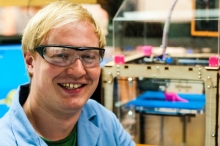
University:
Major:
Mentor(s):
Faculty Sponsor(s):
Faculty Sponsor's Department:
Project Title:
Project Description:
Thermoelectric generators can be used to convert thermal energy into electrical energy. An ideal material has a low thermal conductivity (k), high electrical conductivity (s) and a high Seebeck coefficient (S), which is the voltage difference relative to a temperature difference. Typically, conducting polymers for flexible electronic applications feature low thermal conductivity, but in order to obtain higher electrical conductivity adequate doping of the polymer is required. We study the thermoelectric properties of Poly[2,5-bis(3-tetradecylthiophen-2-yl)thieno[3,2-b]thiophene] (PBTTT) films doped with 4-ethylbenzenesulfonic acid (EBSA). In order to dope spin-coated PBTTT films, we immersed the films in an EBSA solution with optimized concentration. To show the enhancement in conductivity we performed 4-point probe conductivity measurements on doped films with varying immersion times between 5 seconds and several hours. In addition, we followed the same immersion procedure to determine the Seebeck coefficient of the doped films. The performance of EBSA-doped PBTTT as a thermoelectric material is ascertained using the Power Factor (PF=S2s) as a value of reference. We performed UV-Vis-NIR spectroscopy and Electron Paramagnetic Resonance (EPR) spectroscopy to study the optical and electronic transitions of the films. PBTTT films immersed in a 1 weight-% acid solution lead to electrical conductivity of 10 S/cm and approaching 500 S/cm after 5 minutes and 2 hours, respectively. Seebeck coefficient is 100 mV/K after 5 minutes and 20 mV/K after 120 minutes, resulting in a maximum Power factor of 25 µW/K2m. This indicates that EBSA efficiently dopes PBTTT and is a promising dopant in the context of thermoelectricity.
